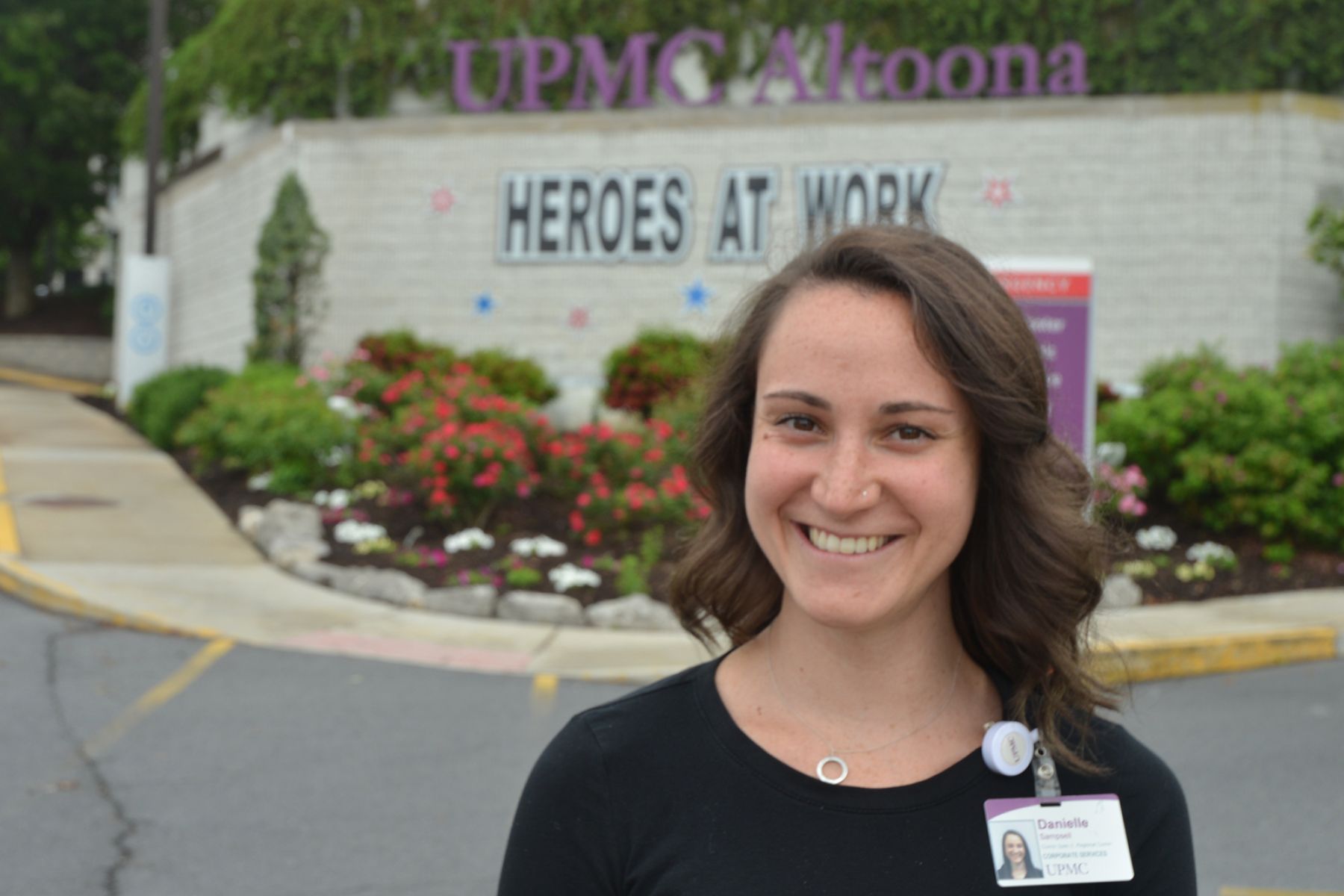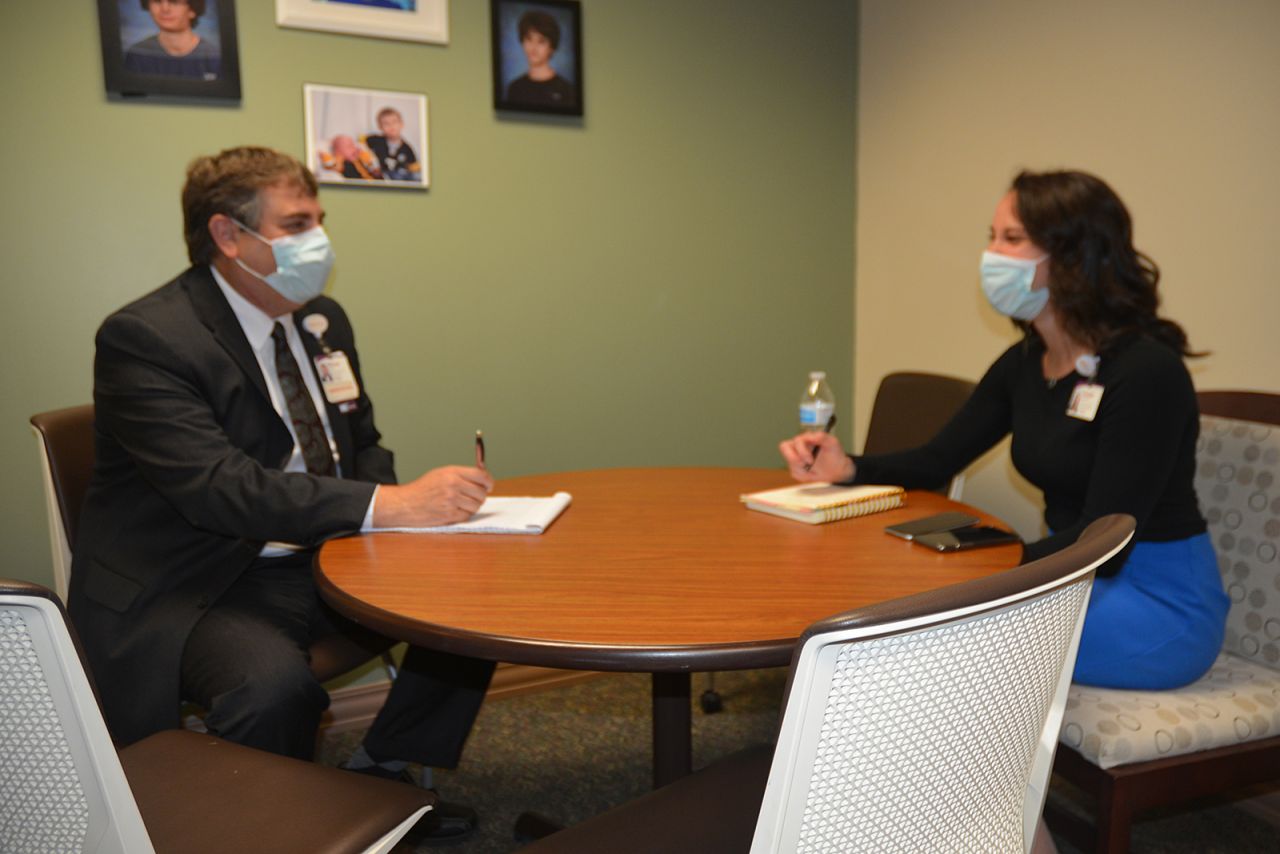Communicating during a crisis — and finding calm, too

It was March 1 and communications specialist Danielle Sampsell’s inbox was overflowing with emails. While vacationing in Utah, the media requests and messages from colleagues would not stop rolling in — unusual, she thought, especially considering her out-of-office message.
By the time she flew back to Centre County four days later, she knew she would not be returning to normal. When Sampsell came back to work — her duties include crisis and internal communications for University of Pittsburgh Medical Center (UPMC) hospitals in southcentral Pennsylvania — she was quickly informed that her entire role would be almost completely flipped upside down.
With the national spotlight shining on the medical arena since the start of the coronavirus pandemic, Sampsell and her fellow Bellisario College alumni in healthcare communications are working hard to bridge the gap between medical professionals and the public in a time of crisis.

When she's working in the hospital, Sampsell's meetings with colleagues like Mike Corso ('94 HHD), vice president of operations of UPMC Altoona and UPMC Bedford, follow safety protocols that require masks.
“I’ve grown so much in a couple months,” said Sampsell, who graduated with an advertising/public relations degree in 2015. “The silver lining in all of this is that the crisis communications experience we all have now is second to none.”
On top of more media requests, Sampsell also had to shift her usual duties for internal communications at UPMC. Within two weeks her team had crafted more than 300 documents regarding COVID-19 information and procedures for their intranet, and they were effectively split into work groups dictated by the chief quality officer.
According to Sampsell, no one on her team has taken a day off since the beginning of March. Though intense, the hands-on experience in crisis communications, both internally and externally, has been an incredible learning opportunity.
Multiple challenges
Cindy Stauffer has also experienced a significant increase in media requests as senior media relations and communications specialist for WellSpan Health. She serves as a conduit for coronavirus information regarding testing, patient care and symptoms — relaying facts from WellSpan’s healthcare experts to their network that stretches from Franklin County to Lebanon County in Pennsylvania.
For Stauffer (’82 Journ), effectively communicating during this crisis has been all about striking a balance. In addition to pitching media and working with internal communications colleagues to inform more than 20,000 employees, Stauffer also works to convey coronavirus information while also reminding communities of everyday health concerns.

Cindy Stauffer's duties include pitching media and working to inform more than 20,000 employees of her healthcare system.
“People are still having strokes and heart attacks and that doesn't go away just because we all have turned our attention to this pandemic,” Stauffer said. “We want people to continue to take care of their health in normal ways too that have nothing to do with COVID, and that's another message that we're trying to emphasize.”
Stauffer is not alone in trying to share information other than coronavirus updates in a pandemic-saturated media climate. Cindy Del Rosario-Tapan (’99 Journ), director of communications for the International Women’s Health Coalition (IWHC) in New York City, is also trying to get through to the media.
“What's been different is that journalists are so overwhelmed right now and it's hard to break through on anything other than COVID,” she said. “It's hard to find a really unique angle and to kind of get through to people because of just the volume and pace at which news is coming out.”
A mission amidst the madness
Previous outbreaks have indicated how women and girls are proportionally impacted by health crises and Del Rosario-Tapan said the coronavirus is no different. She and her four-person communications team have gone into active support mode to continue IWHC’s mission of advancing sexual and reproductive health and rights of women internationally.
Despite the inability to travel, Del Rosario-Tapan said as a grant-making organization they have still been able to support their partners and hear directly about how the crisis is impacting them. Though her hours have remained roughly the same since she began working from home in mid-March, Del Rosario Tapan said the work itself has intensified.
Altered workplaces and schedules
For Katherine Morris (’19 Ad/PR), a business development coordinator at Omnicom Health Group, the work schedule has also accelerated. She has spent many late nights the past several months working at the holiday wrapping station-turned-desk in her parent’s house in upstate New York since her Manhattan office closed.
Morris was accustomed to later nights in the office with colleagues, sharing a meal in a bright conference room while they prepared for important client pitches. Now, Morris said she’s putting in the same work, but working alone in a dark house until as late as 2 a.m., long after the rest of her family is in bed.
“It feels like we're busier now than we were prior to COVID,” Morris said. “We have a lot of new business opportunities coming in and we're really thankful, but we've been in constant pitch mode this entire time.”
Much of Morris’ time had been dedicated to reserving conference rooms, catering for important meetings and other logistical tasks for one of Omnicom’s agencies. Because those responsibilities have been put on hold while the whole office works remotely, she has been working on internal projects to organize case studies for her team and supporting them with smaller tasks as well.
New daily morning and evening video check-ins with her team have been a positive among all the changes for Morris. “If we were in person I wouldn't be connecting with these other team members and building relationships with them as much, so that’s been a really cool aspect of being remote,” she said.
While the crisis has encouraged people to put more effort into building personal relationships and organizing meetings to do so, it has also forced the creativity of communications professionals to bring external events to life virtually. For Del Rosario-Tapan this has been a highlight.
Like many nonprofits, IWHC had to cancel a special event — its 2020 annual dinner in April where the organization honors visionary leaders of the feminist movement. While Del Rosario-Tapan was looking forward to honoring Noelene Nabulivou in person with the Joan B. Dunlop Award for her work as co-founder of Diverse Voices and Action for Equality in Fiji, IWHC quickly adapted and was able to celebrate virtually through a Facebook live film screening.
“I was so proud of having the opportunity to just shine a light on Noelene,” Del Rosario-Tapan said of the film that shared Nabulivou’s story and impact. “I think what I do, and IWHC, really amplifies the work of so many people like her and that's what I'm really proud of.”
What matters to Del Rosario Tapan is that her work in communications makes a difference. Through her current role in promoting women’s health around the world she feels she is doing exactly that, especially now.
Stauffer shared a similar sentiment.
"Healthcare is very interesting, varied work and that's one of the things that attracted me to it. There's technology, but there's also a very human side to taking care of people on their worst days and on their happiest days.”
Cindy Stauffer ('82 Journ)
"Healthcare is very interesting, varied work and that's one of the things that attracted me to it,” Stauffer said. “There's technology, but there's also a very human side to taking care of people on their worst days and on their happiest days.”
With more than 30 years of experience as a journalist, Stauffer said storytelling is still an important part of her role in healthcare communications. As media requests started to slow down after and general coronavirus information became more available, Stauffer said she and her team are starting to return to telling the impactful stories that she loves.
Stauffer has used her storytelling skills to bring both news and narratives to the public. They include a Marine combat artist sketching WellSpan employees in their frontline fight against the coronavirus, an audiologist redeployed to help restock and sanitize equipment during the pandemic, and hospital partnerships with local vulnerable communities.
One challenge for Stauffer has been not physically working in the office, where she said it is easiest to identify powerful stories first-hand. She is adapting though, and finding new opportunities to bring what’s going on inside hospitals safely to the community.
Sampsell can relate. For the communications specialist, getting to work occasionally in the hospital has been grounding, even while her work has intensified. She splits her time in half working from home and at UPMC Altoona and UPMC Bedford.
“I love working in a hospital, and getting to see the nurses and the patients just really humanizes it a lot more,” Sampsell said. “I'm very much appreciative of the fact that I get to see that side of things and be in the clinical environment. It means a lot to me, so I'm glad that hasn't changed much.”



 @ninat515
@ninat515